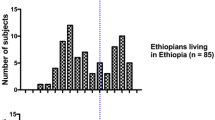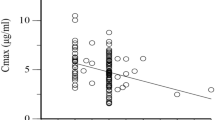Summary
Studies of isoniazid, the well known antituberculosis drug, have revealed that N-acetylation polymorphism, is of great clinical importance. In human, N-acetylation is one of the most important pathways in the inactivation of isoniazid. Caffeine, which is also biotransformed by N-acetylation, has been widely used as anin vivo probe for the assessment of N-acetyltransferase polymorphism. The activity of N-acetyltransferase can be estimated from the urinary metabolic ratio of two caffeine metabolites, namely, 5-acetylamino-6-formylamino-3-methyluracil (AFMU), and 1-methylxathine (1X) after the ingestion of caffeine.
In the present study caffeine was used as a metabolic probe to determine N-acetyltransferase polymorpism in 83 healthy Greek volunteers by means of the molar ratio of AFMU and 1X determined in urine following ingestion of 200 mg caffeine. Frequency distribution analysis of the metabolic ratios AFMU/1X revealed two distinct groups with 66.3% (n=55) slow acetylators and 33.7% (n=28) rapid acetylators. No statistically significant difference was detected between slow and fast acetylators in terms of gender, smoking habits and caffeine-intake habits. These results are in agreement with previous studies on N-acetyltransferase activity in Caucasians using caffeine as a metabolic probe. They also agree with reports on N-acetyltransferase activity in Greek tuberculosis patients using isoniazid as a metabolic probe. Thus, the use of caffeine as a metabolic probe is a reliable method for the assessment of N-acetyltransferase activity in the Greek population.
Similar content being viewed by others
References
Evans D.A.P., Manley F.A., and McKusick V.A. (1960): Genetic control of isoniazid metabolism in man. Br. Med. J., 2, 485–491.
Blum M., Grant D.M., Demierre A., and Meyer U.A. (1989): N-Acetylation pharmacogenetics: A gene deletion causes absence of arylamine N-acetyltransferase in liver of slow acetylator rabbits. Proc. Natl. Acad. Sci. USA, 86, 9554–9557.
Blum M., Grant D.M., McBride W., Heim M., and Meyer U.A. (1990): Human arylamine N-acetyltransferase genes: isolation, chromosomal localization, and functional expression. DNA Cell Biol., 9, 193–203.
Peters J.H., Miller K.S., and Brown P. (1965) The determination of isoniazid and its metabolites in human urine. Anal. Biochem., 12, 379–394.
Mitchell J.R., Thorgeirsson U.P., Black M., Timbrell J.A., Snodgrass W.R., Potter W.Z., Jollow D.J., and Kaiser H.R. (1975): Increased incidence of isoniazid hepatitis in rapid acetylators: Possible relation to hydrazine metabolites. Clin. Pharmacol. Ther. 18, 70–79.
Ellard G.A., and Gammon P.T. (1976): Pharmacokinetics of isoniazid metabolism in man. J. Pharmacokinet. Biopharm., 4, 83–113.
Hyman C.L. (1995): Tuberculosis: a survey and review of the current literature. Curr. Opin. Pulm. Med., 1, 234–242.
Valway S.E., Sanchez M.P., Shinnick T.F., Orme I., Agerton T., Hoy D., Jones J.S., Westmoreland H., and Onorato I.M. (1998): An outbreak involving extensive transmission of a virulent strain of Mycobacterium tuberculosis. N. Engl. J. Med., 338, 633–639.
Curatolo P.W., and Robertson D. (1986): The health consequences of caffeine. Ann. Intern. Med., 98, 641–653.
Grant D.M., Tang B.K., and Kalow W. (1983): Variability in caffeine metabolism. Clin. Pharmacol. Ther., 33, 591–602.
Tang B.K., Grant D.M., and Kalow W. (1983): Isolation and identification of 5-acetylamino-6-formylamino-3-methyluracil as a major metabolite of caffeine in man. Drug Metab. Dispos., 11, 218–220.
Grant D.M., Tang B.K., and Kalow W. (1984): A simple test for acetylatror phenotype using caffeine. Br. J. Clin. Pharmacol., 17, 459–464.
MacLean, C.J., Morton N.E., Elston R.C., and Yee S. (1976): Skewness in commingled distributions. Biometrics, 32, 695–699.
Mead R. (1990): The design of experiments. Cambridge.
McCullagh P., and Nelder J.A. (1989): Generalized linear models. London: Chapman and Hall.
Pontes Z.B., Vincent-Viry M., Gueguen R., Galteau M.M., and Siest G. (1993): Acetylation phenotypes and biological variation in a French Caucasian population. Eur. J. Clin. Chem. Clin. Biochem., 31, 59–68.
Tang B.K., Kadar D., Qian L., Iriah J., Yip J., and Kalow W. (1991): Caffeine as a metabolic probe: validation of its use for acetylator phenotyping. Clin. Pharmacol. Ther., 49, 648–657.
Cascorbi I., Drakoulis N., Brockmoller J., Maurer A., Sperling K., and Roots I. (1995): Arylamine N-acetyltransferase (NAT2) mutations and their allelic linkage in unrelated caucasian individuals: correlation with phenotypic activity. Am. J. Hum. Genet., 57, 581–592.
Ou-Yang D.-S., Huang S.-L., Xie H.-G., Wang C.-Y., and Zhou H.-H. (1998): Use of caffeine as a probe for rapid determination of cytochrome P-450 CYP1A2 activity in humans. Acta Pharmacol. Sinica, 19, 44–46.
Kottakis I. (1992): Phenotypes of isoniazid metabolism in Greece. Ph.D. Thesis, Medical School, University of Athens, Greece.
Hickman D., and Sim E. (1991): N-acetyltransferase polymorphism: comparison of phenotype and genotype in humans. Biochem. Pharmacol., 42, 1007–1014.
Graf T., Broly F., Hoffman F., Probst M., Meyer U.A., and Howland H. (1992): Prediction of phenotype for acetylation and for debresoquine hydroxylation by DNA-tests in healthy human volunteers. Eur. J. Clin. Pharmacol., 43, 399–403.
Iselius L., and Evans D.A.P. Formal genetics of isoniazid metabolism in man. Clin. Pharmacokinet. 8, 541–544, 1983.
Rasmussen B.B., Brosen K. (1996): Determination of urinary metabolites of caffeine for the assessment of cytochrome P4501A2, xanthine oxidase, and N-acetyltransferase activity in humans. Ther. Drug Monit., 18, 254–262.
Campbell M.E., Spielberg S.P., and Kalow W. (1987): A urinary metabolic ratio that reflects systemic caffeine clearence. Clin. Pharmacol. Ther., 42, 157–165.
Lu J.F., Yi T., Cao X.M., Zhuo H.T., and Ling S.S. (1997): Determination of caffeine metabolite for the evaluation of N-acetyltransferase, CYP1A2 and xanthine oxidase activities. Acta Pharm. Sinica, 32, 813–818.
Kalow W., and Tang B.K. (1991): Caffeine as a metabolic probe: exploration of the enzyme-inducing effect of cigarette smoking. Clin. Pharmacol. Ther., 49, 44–48.
West R.W., and Thompson J.R. (1997): Modeling the impact of HIV on the spread of tuberculosis in the United States. Math. Biosci., 143, 35–60.
Ridson R., Kent J.H., Valway S., Weismuller P., Maxwell R., Elcock M., Meador J., Royce S., Shefer A., Smith P., Woodley C., and Onorato I. (1997): Outbreak of drug-resistant tuberculosis with second-generation transmission in a high school in California. J. Pediatr., 131, 863–868.
Harries A.D., Parry C., Nyongonya Mbewe L., Graham S.M., Daley H.M., Maher D., Salaniponi F.M., and Nyangulu D.S. (1997): The pattern of tuberculosis in Queen Elizabeth Central Hospital, Blantyre, Malawi: 1986–1995. Int. J. Tuberc. Lung Dis., 1, 346–351.
Vineis P., Bartsch H., Caporaso N., Harrington A.M., Kadlubar F.F., Landi M.T., Malaveille C., Shields P.G., Skipper P., Talaska G., and Tannenbaum S.R. (1994): Genetically based N-acetyltransferase metabolic polymorphism and low-level environmental exposure to carcinogens. Nature, 369, 154–156.
Author information
Authors and Affiliations
Rights and permissions
About this article
Cite this article
Asprodini, E.K., Zifa, E., Papageorgiou, I. et al. Determination of N-acetylation phenotyping in a greek population using caffeine as a metabolic probe. Eur. J. Drug Metab. Pharmacokinet. 23, 501–506 (1998). https://doi.org/10.1007/BF03190002
Issue Date:
DOI: https://doi.org/10.1007/BF03190002




